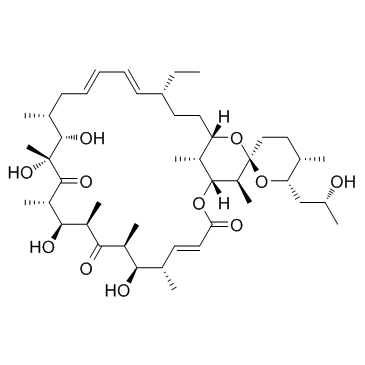Oligomycin A

Oligomycin A structure
|
Common Name | Oligomycin A | ||
|---|---|---|---|---|
| CAS Number | 579-13-5 | Molecular Weight | 791.063 | |
| Density | 1.1±0.1 g/cm3 | Boiling Point | 886.3±65.0 °C at 760 mmHg | |
| Molecular Formula | C45H74O11 | Melting Point | 150-151ºC | |
| MSDS | Chinese USA | Flash Point | 252.0±27.8 °C | |
| Symbol |

GHS07 |
Signal Word | Warning | |
|
Modulators of hepatic lipoprotein metabolism identified in a search for small-molecule inducers of tribbles pseudokinase 1 expression.
PLoS ONE 10 , e0120295, (2015) Recent genome wide association studies have linked tribbles pseudokinase 1 (TRIB1) to the risk of coronary artery disease (CAD). Based on the observations that increased expression of TRIB1 reduces secretion of VLDL and is associated with lower plasma levels ... |
|
|
Functional characterization of CYP107W1 from Streptomyces avermitilis and biosynthesis of macrolide oligomycin A.
Arch. Biochem. Biophys. 575 , 1-7, (2015) Streptomyces avermitilis contains 33 cytochrome P450 genes in its genome, many of which play important roles in the biosynthesis process of antimicrobial agents. Here, we characterized the biochemical function and structure of CYP107W1 from S. avermitilis, wh... |
|
|
Moles of a Substance per Cell Is a Highly Informative Dosing Metric in Cell Culture.
PLoS ONE 10 , e0132572, (2015) The biological consequences upon exposure of cells in culture to a dose of xenobiotic are not only dependent on biological variables, but also the physical aspects of experiments e.g. cell number and media volume. Dependence on physical aspects is often overl... |
|
|
Bioenergetic differences between MCF-7 and T47D breast cancer cells and their regulation by oestradiol and tamoxifen.
Biochem. J. 465(1) , 49-61, (2015) Oestrogen receptor α (ERα+) breast tumours rely on mitochondria (mt) to generate ATP. The goal of the present study was to determine how oestradiol (E2) and 4-hydroxytamoxifen (4-OHT) affect cellular bioenergetic function in MCF-7 and T47D ERα+ breast cancer ... |
|
|
Glycolysis is the primary bioenergetic pathway for cell motility and cytoskeletal remodeling in human prostate and breast cancer cells.
Oncotarget 6(1) , 130-43, (2015) The ability of a cancer cell to detach from the primary tumor and move to distant sites is fundamental to a lethal cancer phenotype. Metabolic transformations are associated with highly motile aggressive cellular phenotypes in tumor progression. Here, we repo... |
|
|
The small molecule C-6 is selectively cytotoxic against breast cancer cells and its biological action is characterized by mitochondrial defects and endoplasmic reticulum stress.
Breast Cancer Res. 16(6) , 472, (2015) The establishment of drug resistance following treatment with chemotherapeutics is strongly associated with poor clinical outcome in patients, and drugs that target chemoresistant tumors have the potential to increase patient survival. In an effort to identif... |
|
|
Krill Oil Ameliorates Mitochondrial Dysfunctions in Rats Treated with High-Fat Diet.
Biomed Res. Int. 2015 , 645984, (2015) In recent years, several studies focused their attention on the role of dietary fats in the pathogenesis of hepatic steatosis. It has been demonstrated that a high-fat diet is able to induce hyperglycemia, hyperinsulinemia, obesity, and nonalcoholic fatty liv... |
|
|
Epithelial-mesenchymal transition induces similar metabolic alterations in two independent breast cancer cell lines.
Cancer Lett. 364 , 44-58, (2015) Epithelial-mesenchymal transition (EMT) induces invasive properties in epithelial tumors and promotes metastasis. Although EMT-mediated cellular and molecular changes are well understood, very little is known about EMT-induced metabolic changes. HER2-positive... |
|
|
Yellow Pigment Aurovertins Mediate Interactions between the Pathogenic Fungus Pochonia chlamydosporia and Its Nematode Host.
J. Agric. Food Chem. 63 , 6577-87, (2015) Nematophagous fungi are globally distributed soil fungi and well-known natural predators of soil-dwelling nematodes. Pochonia chlamydosporia can be found in diverse nematode-suppressive soils as a parasite of nematode eggs and is one of the most studied poten... |
|
|
Apoptolidins A and C activate AMPK in metabolically sensitive cell types and are mechanistically distinct from oligomycin A.
Biochem. Pharmacol. 93(3) , 251-65, (2015) Apoptolidin A was first isolated as a secondary metabolite of a Nocardiopsis sp. and is the founding member of a family of potential selective cancer cell toxins. We now report the isolation, production and pharmacological characterization of apoptolidins A a... |